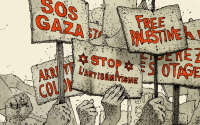16 August 2004Tom EngelhardtZnet
On August 12, 1960, while involved in preparations for developing the American military's initial Single Integrated Operational Plan (SIOP), Admiral Arleigh Burke met with Secretary of the Navy William B. Franke for a blunt discussion. He was disturbed that SIOP strategic planning would be lodged at Offutt Air Force Base because of its "vaunted computer capabilities." Bitter, and fearing that the Air Force was trying to take over all nuclear forces, he referred to his Air Force opposites as "smart and ruthless." As he told Franke, Air Force leaders were using "exactly the same techniques as the Communists" to win Pentagon power struggles. "As a matter of fact [the Air Force's textbooks], originally about ten years ago, were built on the textbooks of the Communists, how to control these things.'"
So what exactly were those Communist flyboys trying to control and dominate? As it happens, Burke was discussing operational planning for world's end. The SIOP -- and the United States has had one of these ever since -- was a full-scale operational plan for a "preemptive" nuclear attack not just on the Soviet Union, but on the Communist world, which was simply to be obliterated. Though inter-service nuking was the order of the day, and much of the back-and-forth was done in an anesthetized language, some military figures were disturbed. At one point, for instance, Marine Corps Commandant David Shoup asked General Thomas Power, Director of Strategic Target Planning, "what would happen if Beijing [slated to be wiped out] was not fighting; was there an option to leave Chinese targets out of the attack plan? Power was reported to have said that he hoped no one would think of that 'because it would really screw up the plan' -- that is, the plan was supposed to be executed as a whole. Apparently Shoup then observed that 'any plan that kills millions of Chinese when it isn't even their war is not a good plan. This is not the American way.'"
The SIOP in preparation even frightened "the devil out of" then-president Dwight D. Eisenhower. And little wonder: the preemptive attack, according to recently declassified documents just posted at the website of the heroic National Security Archive (and carefully sorted out and interpreted by William Burr), was to deliver over 3,200 nuclear weapons to 1,060 targets in the Communist world, including at least 130 cities which would then, if all went well, cease to exist. Official estimates of casualties, Burr tells us, ran to 285 million dead and 40 million injured (and this may have underestimated radiation effects). Army and Navy officials "worried about the lethal impact of downwind fallout, with the Army explicitly concerned about limiting exposure of 'friendly forces and people' to radioactive fallout. By contrast, the Air Force saw no need for additional constraints [on surface nuclear blasts]."
Commander-in-Chief, Pacific (CINCPAC) Harry Felt, considering the massive global fallout that would be engendered by such a strike, offered the reasonable fear "that our weapons can be a hazard to ourselves as well as our enemy." After such a war, of course, "victory" would have been meaningless. There would have been no enemy territory safe enough for us to occupy, just the charred ruins of a world.
In the 1950s, Americans, at the highest levels, endlessly thinking about the "unthinkable," plunged into a future charnel-house planet. Not just military but civilian policy makers soon found themselves writing obsessive science fiction scenarios, not for public consumption but for each other, about a possible "global war of annihilation." In these new combat scenarios, the United States was left on the horns of an unbearable dilemma. It could either forswear meaningful victory -- or strike first, taking on an uncivilized and treacherous role long reserved in our history for the enemy. Early in these years, in secret directives like NSC (National Security Council) 68 or NSC141, these men began to plan for the possibility that 100 atomic bombs landing on targets in the United States would kill or injure 22 million Americans, or that an American "blow" might result in the "complete destruction" of the Soviet Union.
Welcome to sunny Cold War America, those "golden years" of Ozzie and Harriet and Father Knows Best, a time when species-suicide lay on the brain just below the consumer wonders of television or the frozen TV dinner you could eat on a specially produced tray while watching it. This was a time when, on a lazy afternoon in the East you could stay home and catch CBS TV's Walter Cronkite from News Nob at the Nevada Test Site, narrating an atomic test in real time ("ten.... nine... eight...), or listen to the young Morley Safer reporting from the frontlines where troops in trenches waiting only miles from the blast were then to "take" the nuclearized battlefield. (The only sponsors -- I wonder why -- were public service civil defense ads and the like.) Or you could turn to a Disney special, Our Friend the Atom -- such shows, plugging "the peaceful Atom," invariably had portentous male voiceovers invoking humanity's "choice" between eternal (atomic) doom and (atomic) paradise -- to view animated farm animals and plants sparkling like so many Tinkerbells with irradiated promise; or you might play with your H2O Missile, a water-powered "ICBM" (though there was something so palpably unplayful about "nuclear toys").
If the real toll at Hiroshima and Nagasaki was largely hidden from the American public, in private dreams and popular culture a lack of information, of atomic "realism," only led to a splurge of apocalyptic fantasies in which ever more bizarre mutant futures were imagined, all of which put a deformed ending on anything resembling an American tale. Meanwhile, school children periodically huddled under their desks with sirens howling outside for the atomic equivalents of fire drills and learned, amid the stories of their fathers' triumphs, how to imagine ashes where there were burgeoning suburbs.
It's forgotten today that, almost with his first words, John F. Kennedy launched his presidency under the sign of the bomb, invoking its "power to abolish... all forms of human life." The Bomb (capitalized in those days when it had no world-ending competition) was the presiding deity of his inaugural address, its unlimited horror invoked six times in a few brief minutes ("... before the dark powers of destruction unleashed by science engulf all humanity in planned or accidental self-destruction..."); while the most famous radical organization of the 1960s, Students for a Democratic Society (SDS), launched its "new form of politics" in 1962 with the Port Huron Statement in which the bomb also reigned supreme. References to it riddled the text ("... a lifetime saturation with horror... the possibility of limited war becoming illimitable holocaust..."), and then there was this poignant reminder that every strategy for creating a better America these young activists could imagine might prove pointless: "Our work is guided by the sense that we may be the last generation in the experiment with living."
Meanwhile, out in Nevada and in atolls in the Pacific, the military was enacting a cumulative SIOP in real, if extended, time. Before the bomb (and its tests) went underground in 1963 (and Vietnam, that "limited war," took center stage), the U.S. military conducted at least 216 atmospheric as well as underwater nuclear tests (including, despite denials at the time, tests of H-bombs in the American West). These ranged from bombs with a yield of only 197 tons ("Wheeler," Operation PLUMBOB, 1957, Nevada Test Site) to 15 Megatons ("Bravo," Operation CASTLE, 1954, Nam Island off Bikini Atoll), which is almost unimaginable. However, if you want to try to imagine it for a moment, a useful aid might be a remarkable, completely eerie, and eerily beautiful book that came out a year ago, Michael Light's 100 Suns. A coffee-table sized book of 100 stunningly reproduced photos of bomb tests (or sometimes of witnesses to them and soldiers put in their path) from the 1950s and early 1960s, declassified from the Los Alamos National Laboratory and the U.S. National Archives in Maryland, some are in black-and-white, but it's the ones in color that impossible to take your eyes off of. These exist, like early Technicolor, in a completely coherent, thoroughly lurid yet mesmerizing color schema which bears almost no resemblance to any we know. It is an unforgettable record of a future that we have, possibly barely, so far avoided.
Of course, the Pentagon still has a SIOP and an arsenal of approximately 10,000 nuclear weapons to go with it (as does our former superpower enemy) about whose degree of madness we can know nothing whatsoever. As William Burr comments, "Some evidence exists that after the Cold War ended, Strategic Air Command commander-in-chief General Lee Butler tried to curb what he saw as the SIOP's 'grotesque excesses' by paring down the huge target lists. Security classification, however, hides whether General Butler's reforms took hold or whether the SIOP remains an instrument of overkill."
[This article first appeared on Tomdispatch.com, a weblog of the Nation Institute, which offers a steady flow of alternate sources, news, and opinion from Tom Engelhardt, long time editor in publishing and author of The End of Victory Culture and The Last Days of Publishing.]






